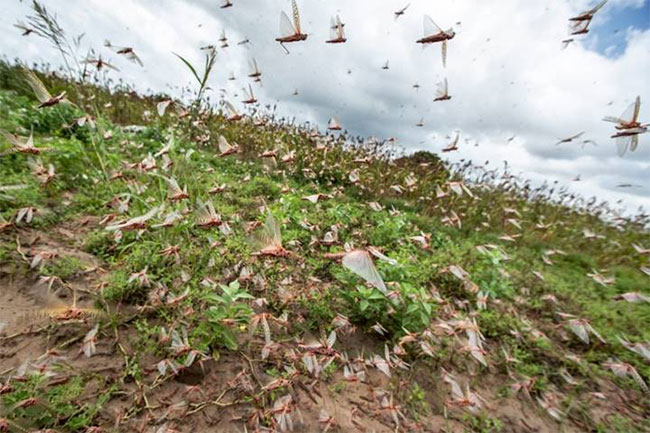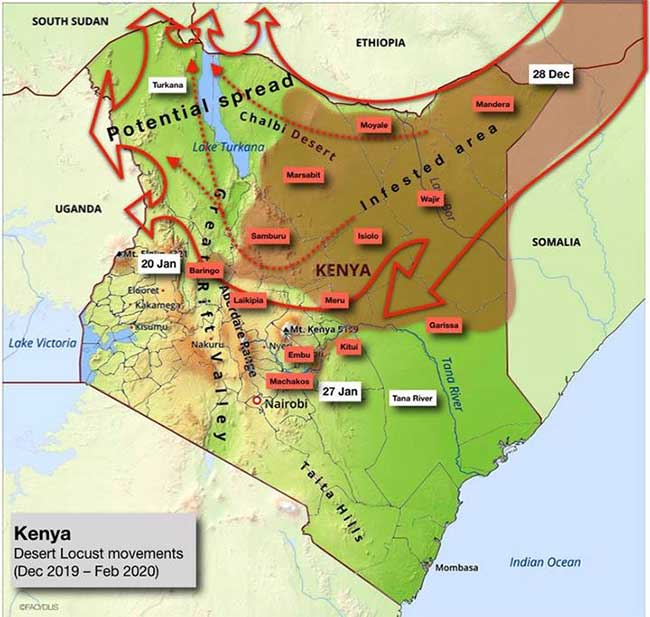Why does modern science and technology still not control locusts?
After a very long journey, people still can not control the locust raging.
In 1937, on sluggish train trains, the US National Guard had to use flamethrowers in an attempt to tame the terrible disaster caused by each grasshopper "legion" crossing Colorado territory. , USA.
But flamethrowers did not penetrate and the explosives were in the same situation. Grasshoppers easily endured and then swallowed the agricultural fields.
More than 80 years later, huge grasshoppers have not been stopped. Last week, the United Nations declared desert desert grasshoppers, the most devastating, suddenly appearing in East Africa, in the coming months this insect could increase the number by 500 times. "Kenya has not faced the threat of grasshoppers on such a scale in the past 70 years , " according to a UN report.
A single swarm of grasshoppers composed of gluttonous locust can cover more than 1,191km of square, which has been a disaster for thousands of years. In the modern era, the British established a grasshopper extermination unit at the height of World War II to fight insects in Africa and the Middle East. In 1976, a New York Times correspondent expected that the progress of science and technology could eliminate the risk of locust epidemics, but today everything remains unchanged, the affliction called victims. Grasshopper does not improve.
"It is not surprising to me that we still cannot control the problem," said Iain Couzin, director of the Max Planck Animal Behavior Institute, who studies grasshoppers.
Today, the best thing that people can do is to experiment and predict where the herd will form before they explode and eventually "chew" out large areas of cultivation, which are means of living. of rural people. "You need to catch it soon," says Rick Overson, research coordinator at the Global Locust Initiative at Arizona State University.

Grasshoppers in Kenya, January 24.

Driving directions and prediction path of desert grasshoppers, January 28, 2020.
Once the grasshopper grows into an adult wing, nothing can turn around."They are strong flying creatures," Overson said. "They can stay in one country and move to another country right over the weekend . " And "during the desert grasshoppers disaster" , the United Nations notes that these "legions" can affect 20% of the land on Earth, more than 65 of the poorest countries in the world and the possibility of damage. to the livelihood of 1/10 of the world's population " .
After the grasshoppers exploded in population or in colonies, a dull strategy that we often use is to spray millions of liters of chemical pesticides onto insects, which is very harmful to the environment and health. healthy people, Overson explained.
But determining exactly where grasshoppers begin to form the herd is extremely difficult, especially for desert grasshoppers in Africa and surrounding areas, the areas are mostly remote and remote. , uninhabited with a size of about 16 million square kilometers, equivalent to more than 6 million square miles. They usually live alone, but once the appropriate environmental conditions (such as after a heavy rainy season), they will attract each other intensely, change color, often grow longer wings and become muscular more, become a frightening herd.
It is important that humans should not attempt to eliminate grasshoppers altogether, as their populations may be harmful. After all, locust is a natural, wild phenomenon. Trying to get rid of insects, even if it's feasible, can have unforeseen environmental consequences."It's one of the wonders of the natural world," Couzin said. "We don't want to stop it, we just want to control it . "
Locust victims have many similarities to wildfires , Overson explained. Surely no one wants his house to be burned down. But widespread forest fire suppression, a natural phenomenon, has led to excessive dense forests, contributing to the cost burden of maintaining the status quo in the western United States. What could kill billions of grasshoppers? It is best not to discuss.
To counter a few super swarms from devouring human food, the main task now is to predict. The United Nations Food and Agriculture Organization is currently trying to predict where the herd will form.
Where will the grasshopper attack? Grasshopper populations can explode after heavy rains at the right time or after a mild winter climate, Overson explained.
But there are a host of other factors that explain Couzin's afflictions."We're just at the top of the iceberg about what we need to know" to be able to make accurate predictions, he said, with many factors influencing the outcome as billions of insects will react. how the weather changes, the food supply hundreds of miles ahead and the number of locusts will kill themselves.

The green area is where the grasshoppers live naturally before swarming.

A desert grasshopper captured by Kenyan farmers.
"Grasshoppers are very fond of cannibalism , " they began to eat each other when the herd formed and the food source was exhausted, according to Couzin. "As soon as resources are limited they will turn to their fellow humans as food . "
Although the grasshoppers impact about one tenth of the Earth's population, research funding for them is scarce. Part of this is because the herd exists for a short, explosive and disappearing cycle, and therefore cannot attract research interest for years or sometimes decades. Moreover, according to Couzin, locusts often do not land on wealthy countries."It affects the poor," he said, so wealthy nations often don't care about it.
However, humans do not completely suffer."We are trying to change the conventional belief that people are passive victims of locusts , " Overson said. We will change their path by creating plentiful lands, providing grasshoppers with the carbohydrate-rich food that they (and us too) love.
However, climate change can make the epidemic more extreme, as the rains become more intense in the context of the planet is gradually warming, which will make grasshoppers grow stronger after the rains big.
- Hundreds of millions of grasshoppers "attack" Africa, destroying crops
- why are Grasshopper gather in packs?
- Mushrooms "green zombies" against locusts
- 4 technologies on cars not applicable in Vietnam
- Modern people use fire to make stone tools from 72000 years ago
- History of ups and downs of birth control pills
- 10 technologies to help people with supernatural abilities
- Science proves: Prehistoric women are stronger than most modern men
- Best science photo 2008
- India's most modern airborne early warning and control system
- Researching the East Sea by modern technology equipment
- Announcing Vietnam Science and Technology Day 18/5
- 10 Vietnamese science and technology events in 2011
- Upgrade control system of Da Lat nuclear reactor
- Vietnam - US cooperation on science and technology
 Why do potatoes have eyes?
Why do potatoes have eyes? 'Tragedy' the world's largest carnivorous life: Death becomes ... public toilet
'Tragedy' the world's largest carnivorous life: Death becomes ... public toilet Tomatoes were once considered 'poisonous' for 200 years
Tomatoes were once considered 'poisonous' for 200 years Detecting microscopic parasites on human face
Detecting microscopic parasites on human face